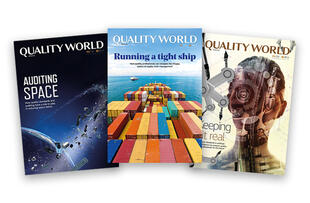Upstream quality assurance
Progress indicator
Stanley O’Donnell, CQP MCQI, Managing Director at Advanced Management Systems, explores the importance of analysing potential risks before launching a project.
With the introduction of the new standard revisions of ISO 9001 quality management systems and AS 9100, an ISO 9001-based quality management system standard focused on aerospace quality, the emphasis on the quality management system structure, context, competence and processes has changed towards a pro-active approach. The focus is on risk analysis of potential problems at the upstream phases of projects in order to avoid production related or in-service related problems.
Typical upstream phases are:
- Concept
- Feed (Front End Engineering Design)
- Release for manufacture or construction
Downstream phases are:
- Construction or manufacturing completion
- Final acceptance and testing
- Commissioning
- Handover and closing out a project
The basis of Upstream Quality Assurance (UQA) is that the proper application of quality principles from the start of any project avoids downstream problems or complications which could lead to added project costs.
The concept of UQA is a tool that can be used effectively and be easily aligned with your QMS to improve your output, thereby your effectiveness, profitability, and customer satisfaction.
Typical engineering, procurement and construction project processes require risk assessment at the following stages in the upstream phase:
- Concept
- Basis for design (BFD)
- Front end engineering design (FEED)
- Detailed design (DD)
- Approved for construction (AFC) / Production FAT (Final Acceptance Test)
These projects also require risk assessments at the following stages in the downstream phase:
Construction (CON)/Production and inspection
Pre-Commissioning/Commissioning
Handover and Close out (HOCO)/ post market data
Project planning
At each stage of the project, the appropriate and effective quality planning and risk management activities are critical to the success of the project in terms of project cost, on schedule achievement, identification of personnel competencies and responsibilities, resources and functional interfaces. Documentation requirements according to the contract and client requirements must also be completed well in advance of all phases.
How to apply the upstream quality assurance approach:
- Form a cross functional team covering all processes from concept to after sales;
- Complete a whole product life cycle risk management assessment plan (RMAP);
- Identify the main risks and assess the requirements to eliminate or mitigate their impact;
- Implement your mitigation/elimination actions and monitor the effectiveness of the outcome;
- Extract lessons learned throughout the project, and add them to your next project at the upstream stage.
The advantages of using upstream quality assurance are:
- Time and cost savings by identifying risks and opportunities at the earliest stages of the project;
- Motivational input from the members of the project risk team, enhancing collective and individual job satisfaction;
- Cost savings by avoiding costly design and production mistakes and non-conforming incidents, repairs and rework;
- Improved productivity;
- No loss of reputation caused by in-service failures;
- Increased customer satisfaction.
Remember the quickest way to improve your effectiveness and productivity is to reduce your incidents of non-conformance.
Quality World

Get the latest news, interviews and features on quality in our industry leading magazine.